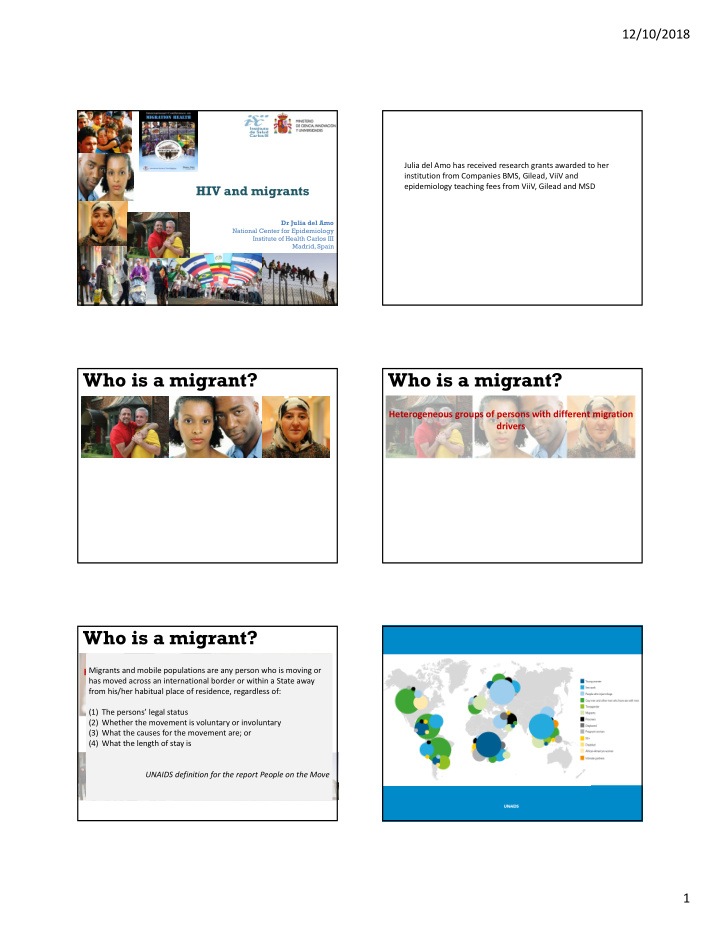



12/10/2018 Julia del Amo has received research grants awarded to her institution from Companies BMS, Gilead, ViiV and HIV and migrants epidemiology teaching fees from ViiV, Gilead and MSD Dr Julia del Amo National Center for Epidemiology Institute of Health Carlos III Madrid, Spain Who is a migrant? Who is a migrant? Heterogeneous groups of persons with different migration drivers Who is a migrant? Migrants and mobile populations are any person who is moving or Heterogeneous groups of persons with different migration has moved across an international border or within a State away drivers from his/her habitual place of residence, regardless of: (1) The persons’ legal status (2) Whether the movement is voluntary or involuntary (3) What the causes for the movement are; or (4) What the length of stay is UNAIDS definition for the report People on the Move Distinct risk-contexts for HIV infections 1
12/10/2018 Proportion HIV diagnoses in migrants * by country of report, EU/EEA 2016 Sweden Malta Ireland Luxembourg Belgium Norway United Kingdom Iceland France Finland Denmark Sub‐Saharan Africa Cyprus Austria 40% EU/EEA Average Central and Eastern Europe Netherlands Germany Western Europe Italy Spain Portugal Latin America and Caribbean Czech Republic Greece Slovenia South and Southeast Asia Croatia Estonia Other Slovakia Bulgaria Lithuania Latvia Poland 0% 10% 20% 30% 40% 50% 60% 70% 80% 90% 100% Percentage of new diagnoses Source: ECDC/WHO (2017). HIV/AIDS Surveillance in Europe 2017– 2016 data New HIV diagnoses, by year of diagnosis, transmission and migration status, EU/EEA, 2007‐2016 Migrant MSM Heterosexual migrants Migrant IDU Data is adjusted for reporting delay 10 Source: ECDC/WHO (2017). HIV/AIDS Surveillance in Europe 2017– 2016 data New HIV diagnoses, by year of diagnosis, transmission and migration status, EU/EEA, 2007‐2016 7000 ‐2% 6000 Number of diagnoses 5000 ‐36% 4000 ‐9% 3000 +58% 2000 1000 0 2007 2008 2009 2010 2011 2012 2013 2014 2015 2016 Year of diagnosis MSM (born in reporting country) MSM (foreign‐born) Heterosexual (born in reporting country) Heterosexual (foreign‐born) Source: ECDC/WHO (2017). HIV/AIDS Surveillance in Europe 2017– 2016 data 2
12/10/2018 HIV epidemics in migrants from Latin America & Caribbean in Europe are driven by MSM TUPEC190 53% of the HIV reports from LAC 2004‐2015 were MSM; 84% of reports from South America to 46% of reports from the Caribbean Unknown region SA men Andean men MSM from all sub‐regions consistently show higher CD4 counts at HIV diagnosis HIV dynamics in migrants from Central, Eastern and Western Europe in Factors underlying high rates of HIV the Europe Union/Economic Area (EU/EEA) infection THPEC174 In Western, Central and Eastern European migrants, 74%, 57% and 26% Those driving Risk behaviors of the HIV reports MSM HIV in and risk countries of WE men contexts during origin migration CE men transit Risk behaviors and risk contexts in countries of MSM from all sub‐regions consistently show higher CD4 counts at HIV destination diagnosis Pre and post-migration Stat Methods Med Res December 2017 HIV acquisition aMASE CASCADE: repeated mesurements that allow to estimate trends in CD4 and VL after seroconversion. • CD4 • VL • AIDS • Sociodemographic characteristics HIV acquisition HIV Diagnosis Before or after migration? 3
12/10/2018 2249 migrants living with HIV Geographical origin 68% men 46% MSM Western Central Eastern SSA LA & Asia Other Caribbean 11% 10% 5% 33% 31% 5% 5% 36 years median age MSM were more likely to… To be single Approx 72% of migrant MSM and 50% heterosexual Estimated post‐migration HIV acquisition probability To have stable residency status migrants from SSA acquired HIV post‐migration (95% CI) by country of destination To have higher education & income Higher socio-economic status than heterosexuals and PWID Barriers to access testing and care in migrants Location of barriers • Structural • Healthcare Barriers act in synergy limiting • Community levels access to, or acceptance of, HIV testing, treatment uptake and responses Nature of barriers • Socio-economic inequalities • Legal • Stigma and discrimination • Cultural & linguistic & gender • Psychological “low risk perception” They undermines public health • Homophobia approaches for HIV control 4
12/10/2018 Status of formal PrEP implementation in Europe Availability of ART for undocumented migrants, 2018 July, 2018 Source: ECDC. From Dublin to Rome: ten years of responding to HIV in Europe and Central Asia: Stockholm, ECDC; 2014 Source: ECDC. Dublin Declaration monitoring 2018; validated unpublished data. Source: ECDC. Dublin Declaration monitoring 2018; validated unpublished data. HIV challenges for migrant populations • Better understanding of HIV transmission dynamics at local level • Global & inclusive HIV prevention and treatment strategies in origin & destination • Increase HIV&STI testing & linkage to care • PrEP & comprehensive STIs approaches • Universal access to ART in Europe … including PrEP Thank you 5
Recommend
More recommend